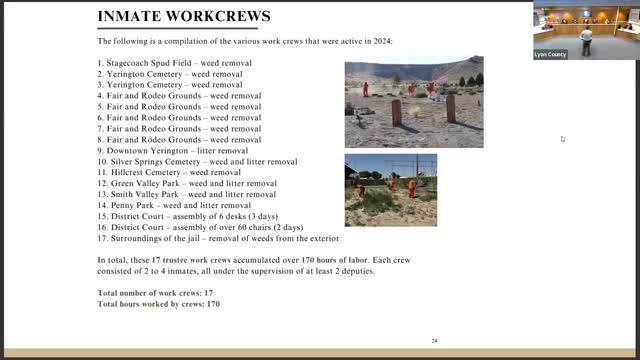County health review, feasibility study and new public‑health campaign proposed to boost outreach
January 18, 2025 | Lyon County, Nevada
This article was created by AI summarizing key points discussed. AI makes mistakes, so for full details and context, please refer to the video of the full meeting. Please report any errors so we can fix them. Report an error »

Three connected public‑health items reached the commission on Jan. 16: results of a statewide foundational public health services assessment, the Quad‑County Health District feasibility study, and a county public communications plan funded from SB 118.
Foundational public health assessment: NACO presented the state‑wide FPHS assessment and highlighted Lyon County strengths and gaps. Lyon County had among the highest local participation in the workshop phase, with 24 community leaders taking part. The assessment rated Lyon County as having moderate expertise and capacity across several foundational functions (communicable disease control, emergency preparedness, community partnerships) and identified communications as a high‑value, near‑term focus for investment and coordination.
Quad‑County Health District feasibility study: County staff presented a consultant report on whether Douglas, Lyon, Storey and Carson City could create a joint health district. Two models were examined: (1) embedding a regional district office in an existing agency (deemed not feasible or desirable by the advisory group) and (2) forming a freestanding health district. The consultant concluded a standalone Quad‑County district could be desirable but is not feasible under current law and financing: the estimated startup and operating costs were substantially higher than available county assessments and would create a large new, ongoing county expense. Staff noted pending state statutory questions, especially responsibilities tied to water and environmental health under NRS 445, that could alter a future feasibility conversation.
LiveBetterLyon public health campaign: County staff described a contract awarded after an RFP to a marketing firm (HeyFrank) to build a one‑year campaign under the umbrella LiveBetterLyon.org using SB 118 funding. The county’s subcommittee chose three priority campaign themes for 2025 — sexually transmitted infections (April–May), behavioral health (Sept–Oct) and road safety (Nov–Dec) — and said the work will include a microsite, yard signs, targeted social buys and print materials. Staff and the contractor plan to track metrics and key performance indicators — site visits, service referrals, and selected safety data — to measure impact and report results to commissioners.
Why it matters: The assessment gives commission and county staff a planning baseline for public health services; the Quad‑County study warns that a voluntary creation of a new district has heavy fiscal consequences; the communications campaign offers an immediate investment to raise awareness and direct residents to local services.
Ending: Commissioners heard that the documents supply a roadmap for next steps: use the assessment to guide local investments, note the Quad study’s fiscal findings if future legislation or multijurisdictional talks surface, and track performance of LiveBetterLyon once it launches. No binding action was taken on district formation; the county will continue to receive state programs while pursuing local outreach.
Foundational public health assessment: NACO presented the state‑wide FPHS assessment and highlighted Lyon County strengths and gaps. Lyon County had among the highest local participation in the workshop phase, with 24 community leaders taking part. The assessment rated Lyon County as having moderate expertise and capacity across several foundational functions (communicable disease control, emergency preparedness, community partnerships) and identified communications as a high‑value, near‑term focus for investment and coordination.
Quad‑County Health District feasibility study: County staff presented a consultant report on whether Douglas, Lyon, Storey and Carson City could create a joint health district. Two models were examined: (1) embedding a regional district office in an existing agency (deemed not feasible or desirable by the advisory group) and (2) forming a freestanding health district. The consultant concluded a standalone Quad‑County district could be desirable but is not feasible under current law and financing: the estimated startup and operating costs were substantially higher than available county assessments and would create a large new, ongoing county expense. Staff noted pending state statutory questions, especially responsibilities tied to water and environmental health under NRS 445, that could alter a future feasibility conversation.
LiveBetterLyon public health campaign: County staff described a contract awarded after an RFP to a marketing firm (HeyFrank) to build a one‑year campaign under the umbrella LiveBetterLyon.org using SB 118 funding. The county’s subcommittee chose three priority campaign themes for 2025 — sexually transmitted infections (April–May), behavioral health (Sept–Oct) and road safety (Nov–Dec) — and said the work will include a microsite, yard signs, targeted social buys and print materials. Staff and the contractor plan to track metrics and key performance indicators — site visits, service referrals, and selected safety data — to measure impact and report results to commissioners.
Why it matters: The assessment gives commission and county staff a planning baseline for public health services; the Quad‑County study warns that a voluntary creation of a new district has heavy fiscal consequences; the communications campaign offers an immediate investment to raise awareness and direct residents to local services.
Ending: Commissioners heard that the documents supply a roadmap for next steps: use the assessment to guide local investments, note the Quad study’s fiscal findings if future legislation or multijurisdictional talks surface, and track performance of LiveBetterLyon once it launches. No binding action was taken on district formation; the county will continue to receive state programs while pursuing local outreach.
View full meeting
This article is based on a recent meeting—watch the full video and explore the complete transcript for deeper insights into the discussion.
View full meeting